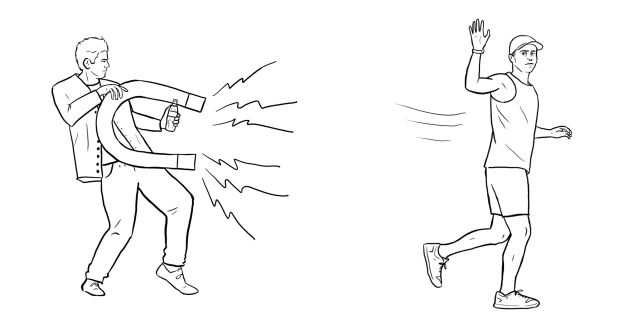Persuasion
If You Really Want to Convince Someone, Start With the No
Opening with the cons is more impactful. And it makes you more credible.
Updated January 26, 2024 Reviewed by Davia Sills
Key points
- People tend to start persuading by outlining their yeses, yet they should first address the other party's nos.
- Sometimes, one can find out why they would say no simply by asking.
- If gathering info in advance isn't possible, try the premortem technique.
- Starting with the nos will also make someone more credible.

When we try to convince our partner to spend the winter holidays at a cabin in the mountains (and not at his parents, again), when we try to attract an angel investor for our startup, or when we plead to our overweight dad to at least consider eating less, we normally tend to start with arguments that support our own perspective.
That is precisely why our persuasion efforts often fail.
We reflexively open with our pros, with our yeses, and completely ignore why our partner would object, why the angel investor would refuse, and why Dad would hate to change his lifestyle. Unfortunately, the other’s cons, their nos, are more powerful than our yeses. Starting with addressing the other person’s nos may seem counterintuitive and even unnatural, but it’s much more impactful.
Research in the psychology of communication differentiates between one-sided communication, in which someone only presents arguments for their claim, and two-sided communication, in which a person also brings up (and refutes) counterarguments to their own position. In his meta-analysis on the issue, communication and social influence professor Mike Allen concludes that an unfavorable audience will be better convinced with two-sided communication. We should, then, present both the pros and the cons of our perspective. And I argue that we should start with the cons.
Imagine two scenarios
It’s summer, and I go out for a run in the park. You sell soda at the kiosk. Make me buy a soda! Give me two or three short arguments to buy a soda from you. Ready? Good.
Now, the roles are switched. It’s summer, and you go out for a run. I sell soda at the kiosk, and I just tried to sell you a soda, but you said no. Why did you say no? Why didn’t you buy the soda? What are two or three arguments for saying no? Got this one, as well? Good.

I ran this little exercise in many of my classes with both undergraduate students and experienced managers. If you are like most people, you probably tried to convince me to buy the soda by saying things such as: “It’s cold and refreshing,” “It quenches your thirst,” “It gives you an energy boost,” “You deserve it, after such a good effort,” or even “I’ll make you a discount.”
When refusing the soda, on the other hand, you most likely thought of reasons like: “I don’t drink fizzy drinks when I run,” “I never stop in the middle of the lap,” “I don’t carry a wallet,” or “Sorry, I just had another soda five minutes ago.”
One interesting observation when looking at the two sets of reasons is that the second set has nothing to do with the first. The arguments are not about the same issues with a reversed sign; they are in totally different ballparks.
If we compare the two sets of reasons, it’s clear that the arguments in the second set are way more powerful. If I don’t drink anything fizzy when I run, I don’t care that your soda is refreshing. If I never stop in the middle of my lap, the fact that it may quench my thirst is irrelevant. If I don’t carry any money, I can’t benefit from your discount.
How do the two sets differ? The first contains yeses (cold, refreshing, energy boost, discount), while the second contains nos (no fizzy drinks, no stops, no money). Also, the first arguments are more generic; the second ones are personal. Unfortunately, our brain is wired so that a personalized no beats a generic yes anytime. And yet, we always open with the yeses, talking about the advantages of our perspective instead of dealing with its disadvantages. We naturally tend to emphasize the pros when we should start by addressing the cons.
How would that go? In our soda-on-the-run example, once we identified the other person’s nos, we could say things like, “Hey! I know you don’t have your wallet, but you can have a soda now and pay me tomorrow; I see you running here all the time,” or, “Try paying with your phone or with your running watch.” It’s a trivial example, but prioritizing, in our persuasion, the other person’s nos also works in difficult personal conversations or in business pitches. If you are a salesperson trained to always present your product or service in the best light possible, this may be a hard pill to swallow. But it works.
However, in order to address the other’s nos, we first need to identify them. How do we do that? The easiest method is to ask. This article is the second in my series about persuasion. In the previous, I argued that if you want to convince someone, you need to start by mapping their mind. You can use the insights in that article to map their mind for nos.
What if we cannot ask? It would be weird to ask strangers why they wouldn’t buy sodas from a kiosk. What if we do not have a chance to talk to the investors before pitching on stage? Then, we might need to put ourselves in the other person’s shoes and make a good guess.
A useful method to do that is inspired by premortem, a clever project management technique invented by psychologist Gary Klein: Pretend that the discussion or the pitch was yesterday and the other person already said no; then try thinking of two or three reasons why they did so. Finally, think of clever ways to deal with those identified objections.
For example, pretend you already had that discussion with your partner about the winter holidays and that he already said no to your suggestion. Why did he? Could it be because he already promised his mom you both are coming? If this is the case, when the real conversation takes place, instead of picturing the advantages of a romantic getaway in the mountains, start with an argument along these lines: “I know you already promised your mom we’re going, but…”
Sometimes, we are stuck in our own perspective and cannot empathize well enough to discover the real nos of the person we are trying to convince.
Here are three ways to overcome this:
- Write them down. Using pen and paper structures and opens our thinking.
- Talk to someone. Ask a friend to help you prepare the pitch by pretending she’s an investor. Then, ask her to think of reasons for turning down the investment, reasons you have not anticipated.
- Ask ChatGPT. Have AI be your sparring partner. Prompt it to act like the person you want to convince, and ask it why it would say no. It works really well.
There’s another advantage to starting your persuasion attempt by bringing up counterarguments to your own position: You will seem more credible. The person you talk to will no longer perceive the conversation as a fight, will feel understood, and might even open up. Give it a try. And tell me how it went.
References
Allen, M. (1991). Meta-Analysis Comparing the Persuasiveness of One-sided and Two-sided Messages. Western Journal of Speech Communication, 55, 390-404.
Klein, G. (2007). Performing a Project Premortem. Harvard Business Review, 09.




